Unknown origin
Where these coins were minted is still uncertain. One suggestion is they were minted at the Tower of London. When these coins were minted has been the subject of debate for the past two hundred and sixty years. Proposed dates for these coins have been 1641–1642; 1667–1669; 1672–1674. The current thinking is they were minted between 1646 and 1660 before the official reign of Charles II of England, while he was in exile, due to new documents recently discovered by John N. Lupia and published in the C4 Newsletter 2008. Who coined them and the circumstances surrounding them is still uncertain. Two candidates: Pierre Blondeau or Nicholas Briot have been proposed as the designer of these coins, but both the former suggestion seem unlikely. John N. Lupia has published in the C4 Newsletter 2009 new documentary evidence that shows both the small and large copper coins are halfpence. The small issue was minted 1646–1660, and the larger from 1688 to 1690.
One smaller copper specimen bears a counterstamp along the base of the obverse that reads MDLIII, which may suggest a date of 1553, but that is far too early to be taken seriously.
It is purported that about 450 different die varieties exist of this series on the small coin. Approximately 1,100 specimens are known in census. The number of coins minted has been guessed to be somewhere in the vicinity of approximately 1,500,000 to more than 7,000,000 pieces.

The history of the English penny from 1603 to 1707 covers the period of the House of Stuart, up to the Acts of Union of 1707 which brought about the Union of the Kingdom of England with the Kingdom of Scotland.

The penny of Great Britain and the United Kingdom from 1714 to 1901, the period in which the House of Hanover reigned, saw the transformation of the penny from a little-used small silver coin to the bronze piece recognisable to modern-day Britons. All bear the portrait of the monarch on the obverse; copper and bronze pennies have a depiction of Britannia, the female personification of Britain, on the reverse.

The British farthing abbreviated qua., was a denomination of sterling coinage worth 1/960 of one pound, 1/48 of one shilling, or 1/4 of one penny; initially minted in copper and then in bronze, which replaced the earlier English farthings. Before Decimal Day in 1971, Britain used the Carolingian monetary system, wherein the largest unit was a pound sterling of 20 shillings, each of 12 pence. Each penny was divided into 4 farthings, thus, a pound sterling contained 960 farthings, and a shilling contained 48 farthings. From 1860 to 1971, the purchasing power of a farthing ranged between 12p and 0.2p in 2017 values.

The two-cent piece was produced by the Mint of the United States for circulation from 1864 to 1872 and for collectors in 1873. Designed by James B. Longacre, there were decreasing mintages each year, as other minor coins such as the nickel proved more popular. It was abolished by the Mint Act of 1873.
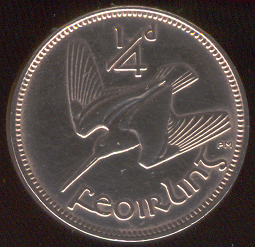
The farthing was the lowest value coin of the pre-decimal Irish pound, worth a quarter of a penny, 1⁄48 of a shilling or 1⁄960 of a pound. The coin had lost much of its value through inflation long before decimalisation in 1971, and during the 1960s no farthings were produced for general circulation; those minted in 1966 were produced for collectors' sets.
There have been three sets of coins in Ireland since independence. In all three, the coin showed a Celtic harp on the obverse. The pre-decimal coins of the Irish pound had realistic animals on the reverse; the decimal coins retained some of these but featured ornamental birds on the lower denominations; and the euro coins used the common design of the euro currencies. The pre-decimal and original decimal coins were of the same dimensions as the same-denomination British coins, as the Irish pound was in currency union with the British pound sterling. British coins were widely accepted in Ireland, and conversely to a lesser extent. In 1979 Ireland joined the Exchange Rate Mechanism and the Irish pound left parity with sterling; coin designs introduced after this differed between the two countries.

The American twenty-cent piece is a coin struck from 1875 to 1878, but only for collectors in the final two years. Proposed by Nevada Senator John P. Jones, it proved a failure due to confusion with the quarter, to which it was close in both size and value.
The British farthing was a British coin worth a quarter of an old penny. It ceased to be struck after 1956 and was demonetised from 1 January 1961.

The Indian Head cent, also known as an Indian Head penny, was a one-cent coin ($0.01) produced by the United States Bureau of the Mint from 1859 to 1909. It was designed by James Barton Longacre, the Chief Engraver at the Philadelphia Mint.
Irish coins have been issued by a variety of local and national authorities, the ancient provincial Kings and High Kings of Ireland, the Kingdom of Ireland (1541–1801), the United Kingdom of Great Britain and Ireland (1801–1922), the Irish Free State (1922–1937), and the present Republic of Ireland. Since 2002, the Republic of Ireland has minted Euro coins, featuring symbols such as flax and the harp.

The Flying Eagle cent is a one-cent piece struck by the Mint of the United States as a pattern coin in 1856 and for circulation in 1857 and 1858. The coin was designed by Mint Chief Engraver James B. Longacre, with the eagle in flight based on the work of Longacre's predecessor, Christian Gobrecht.

The British halfpenny coin was worth 1/480th of a pound sterling. At first in its 700-year history it was made from silver, but as the value of silver increased the coin was made from base metals. It was finally abandoned in 1969 as part of the process of decimalising the British currency. "Halfpenny", colloquially written ha'penny, was pronounced HAY-pə-nee; "1 ½d" was spoken as a penny ha'penny or three ha'pence.

Conder tokens, also known as 18th-century provincial tokens, were a form of privately minted token coinage struck and used during the later part of the 18th century and the early part of the 19th century in England, Anglesey and Wales, Scotland, and Ireland.
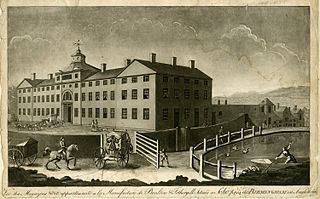
Soho Mint was created by Matthew Boulton in 1788 in his Soho Manufactory in Handsworth, West Midlands, England. A mint was erected at the manufactory containing eight machines, to his own patent design, driven by steam engine, each capable of striking 70 to 85 coins per minute.

The Australian pre-decimal halfpenny coin, commonly known as a ha’penny, was the smallest denomination of the Australian Pound in circulation. It was a unit of currency that equalled half of a penny, 1/24 of a shilling, or 1/480 of a pound. The coin was made to be equivalent to the British halfpenny; its dimensions, composition and values were equivalent, and additionally, the two currencies were fixed at par.
William Wood (1671–1730) was an English hardware manufacturer, ironmaster, and mintmaster, notorious for receiving a contract to strike an issue of Irish coinage from 1722 to 1724. He also struck the 'Rosa Americana' coins of British America during the same period. Wood's coinage was extremely unpopular in Ireland, occasioning controversy as to its constitutionality and economic sense, notably in Jonathan Swift's Drapier's Letters. The coinage was recalled and exported to the colonies of British America. Subsequently, Wood developed a novel but ineffective means of producing iron, which he exploited as part of a fraudulent investment scheme.
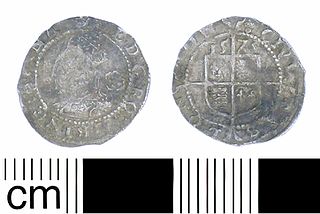
The English three halfpence, a silver coin worth 1+1⁄2d, was introduced in Elizabeth I's third and fourth coinages (1561–1582) as part of a plan to produce large quantities of coins of varying denominations and high silver content. The obverse shows a left-facing bust of the queen, with a rose behind her, with the legend E D G ROSA SINE SPINA – Elizabeth by the grace of God a rose without a thorn – while the reverse shows the royal arms with the date above the arms and a mintmark at the beginning of the legend CIVITAS LONDON – City of London, the Tower Mint.
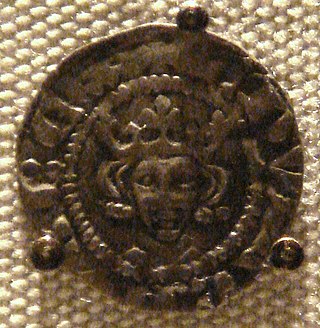
The English farthing was a coin of the Kingdom of England worth 1⁄4 of a penny, 1⁄960 of a pound sterling. Until the 13th century, farthings were pieces of pennies that had been cut into quarters to make change. The first English farthing coins were minted in the 13th century, and continued to be struck until the early 18th century, when England merged into the Kingdom of Great Britain in 1707.
The Copper Panic of 1789 was a monetary crisis of the early United States that was caused by debasement and loss of confidence in copper coins that occurred under the presidency of George Washington.
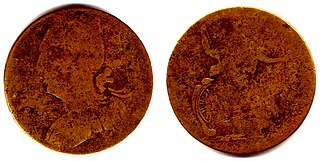
Blacksmith tokens are a form of evasion currency that was in circulation primarily in Lower Canada and Upper Canada along with neighboring areas, such as the northern parts of New York and New England in the mid-1820 to 1830s. They were not, strictly speaking counterfeits, but instead skirted around the laws of the time by being similar to officially circulating coinage, but bearing different legends, or bearing no legends or dates at all, so it could not be claimed that they were truly imitating circulating coinage fully. The tokens were designed to resemble worn examples of English or Irish copper coinage, most often with a crude profile of either George II or George III in profile on the obverse and an image of Britannia or an Irish harp on the reverse. They were typically underweight when compared to officially sanctioned halfpenny coinage, but were accepted along with many other unofficially issued tokens due to a lack of sufficient small denomination coinage in circulation at the time.














